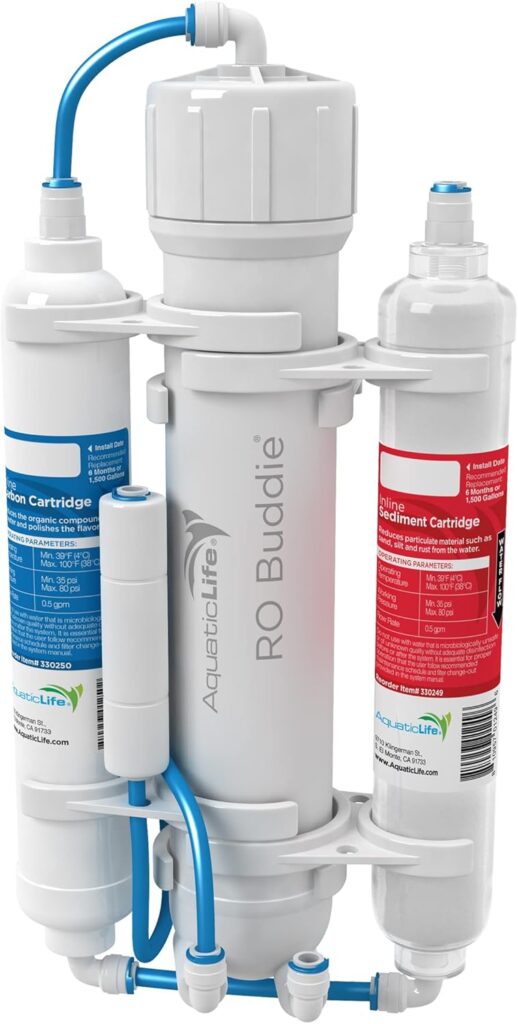A RO/DI (Reverse Osmosis/Deionization) system is an essential tool for maintaining a healthy and thriving aquarium, especially for saltwater and reef tanks where water purity is critical. This system removes impurities, contaminants, and dissolved solids from tap water, providing ultra-pure water for your aquarium.
How a RO/DI System Works
- Sediment Filtration: Water first passes through a sediment filter, which removes larger particles like sand, silt, and rust. This step protects the RO membrane from clogging.
- Carbon Filtration: The water then moves through a carbon filter, which removes chlorine, chloramines, and volatile organic compounds (VOCs). Chlorine and chloramines are particularly harmful to both the RO membrane and aquatic life.
- Reverse Osmosis (RO) Membrane: The heart of the system, the RO membrane, removes up to 98-99% of dissolved salts, heavy metals, and other impurities. The water is pushed through this semi-permeable membrane, leaving most contaminants behind as waste.
- Deionization (DI) Resin: The final stage involves passing the water through a DI resin, which removes any remaining ions, resulting in water that is nearly 100% pure. This stage is crucial for reef aquariums where even trace elements can cause issues.
Benefits of Using a RO/DI System
- Purity: RO/DI water is free from impurities like nitrates, phosphates, and silicates that can promote algae growth and harm sensitive aquatic life.
- Stable Water Chemistry: Pure water provides a blank slate, allowing you to precisely control the water chemistry in your aquarium by adding only the necessary salts and minerals.
- Healthier Livestock: Cleaner water reduces the risk of introducing harmful contaminants into your aquarium, leading to healthier fish, corals, and invertebrates.
- Prevention of Algae Blooms: By removing contaminants like phosphates and silicates, a RO/DI system helps prevent algae blooms, which can be difficult to control once they start.
Maintenance of a RO/DI System
Regular maintenance is crucial to ensure the system functions effectively:
- Replace Filters: Sediment and carbon filters should be replaced every 6-12 months, depending on water quality and usage.
- Monitor the RO Membrane: The RO membrane typically lasts 2-3 years but should be replaced when its efficiency drops, which can be monitored using a TDS (Total Dissolved Solids) meter.
- Change DI Resin: DI resin changes color as it becomes exhausted, and it should be replaced when this happens to maintain water purity.
Choosing a RO/DI System
When selecting a RO/DI system for your aquarium, consider the following factors:
- Water Output: Measured in gallons per day (GPD), choose a system that matches your aquarium’s water needs.
- Stages of Filtration: A typical system has 4-5 stages, but more advanced systems can have additional stages for even higher purity.
- Ease of Maintenance: Look for systems with easy-to-replace filters and readily available replacement parts.
- Wastewater Ratio: RO systems produce wastewater, which can range from 1:1 to 4:1 (wastewater). Lower waste ratios are more efficient and environmentally friendly.
Conclusion
A RO/DI system is an investment in the long-term health and stability of your aquarium. By providing ultra-pure water, it helps create an ideal environment for your aquatic life, reducing the risk of contaminants and ensuring that your tank inhabitants thrive. Regular maintenance and careful selection of the system will maximize its benefits, leading to a healthier and more vibrant aquarium.


